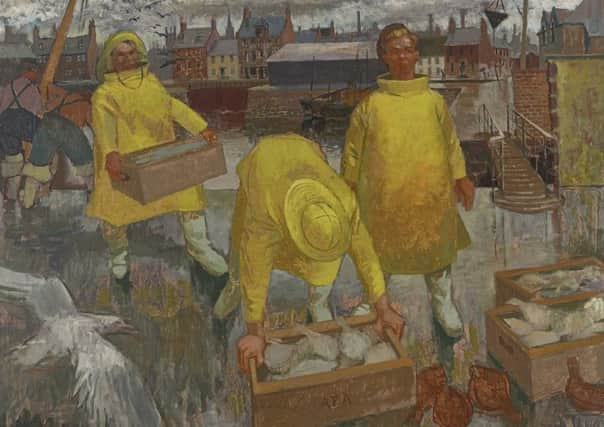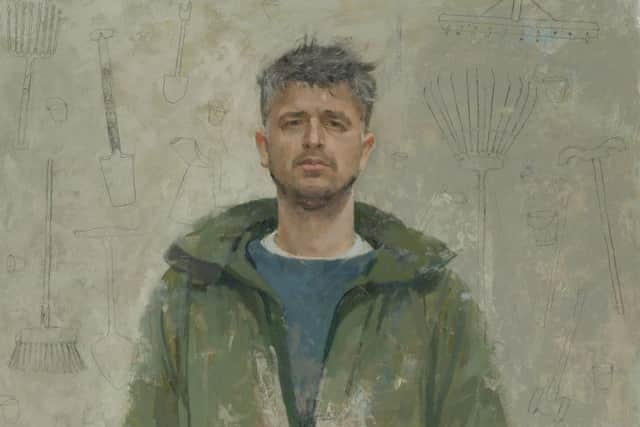Art reviews: Hidden Gems at Edinburgh City Art Centre | The Scottish Portrait Awards 2017


Hidden Gems ****
Songs For Winter ****
A Fine Line ****


Playfair and the City ****
All at City Art Centre, Edinburgh
The Scottish Portrait Awards 2017 ****
Scottish Arts Club, Edinburgh


The only complaint was that for years it was scarcely seen. That has changed and now at last its riches are becoming more familiar. Even so there is still much still unseen and Hidden Gems, the latest exhibition at the City Art Centre, is a selection of these rarely seen or even unseen works. High points include a large painting by ET Crawford, an early 19th century painter who took his inspiration from the Dutch 17th century. This painting is a gorgeous homage to Aelbert Cuyp. A Lancashire Village by William Wells is another major landscape. A casual scene of houses by a wide estuary with fishing nets, hens and women standing quietly chatting, it is more modern, but also Dutch in mood. There is a very fine large still life by James Cumming and a magnificent painting of Arbroath Harbour by Morris Grassie with big men in yellow oilskins hauling boxes of fish. Les Jouers is a major work by Mary Cameron, an otherwise little known Scottish artist, but a contemporary of the Colourists. It is a large painting of Spanish card players with a lovely still life of peppers and a water melon in the foreground. Represented by a bronze bust of FS Oliver, sculptor and pupil of Rodin, Ottilie Maclaren Wallace is another artist who has dropped out of the story of Scottish art. Ancell Stronach, a Symbolist follower of John Duncan, is also rarely seen, but his stylised painting of the Nativity, The Other Wise Man, is an impressive picture. It illustrates The Story of the Other Wise Man written by Henry van Dyke about a fourth wise man who followed the usual three. (Stronach we are told later gave up painting to tour his music hall act, Ancel and his Forty Painted Pigeons.) The Green Hat by Bessie McNicol is superb, but also the only picture here that is generally better known.
Not everything is Scottish, however. There is a large landscape of Devon by Lucien Pisarro and several drawings and a single sculpture by Anthony Hatwell, who came from the south to be Head of Sculpture at ECA, are a revelation. A beautiful drawing of Naomi Mitchison by Wyndham Lewis shows a Scottish sitter recorded by a leading English Modernist. Other works on paper include prints by Henry Moore, RB Kitaj and Eduardo Paolozzi and a group of lithographs by Robert Henderson Blyth, William Wilson and others from the pioneering Edinburgh workshop of the Harley Brothers. There are now nearly 5,000 works in the City’s collection. The quality of this group of some that are rarely seen suggests something of its depth and range.
Advertisement
Hide AdAdvertisement
Hide AdAlthough, to the great advantage of its remarkable collection, ECAC has cut back its exhibition programme, it has not abandoned it altogether and indeed there are three other exhibitions concurrently with Hidden Gems. The largest, Songs for Winter, is a very beautiful display of work by Pauline Burbridge and Charles Pulsen. Their work is quite distinct, but nevertheless has a visible affinity. Both are evidently inspired by the simplicity of minimalism, but both also soften its usual austerity to achieve something gentler, more accessible and more poetic. Pauline Burbridge makes quilts, but combines stitching and occasionally dyeing with drawing to create a unique art form. Her motifs are drawn from nature: grasses, seed heads and, in one remarkable quilt, patterns of light on water. Mostly monochrome, they are arranged in simple, regular, but not severe patterns of squares or horizontal bands. The quilted fabric is at once support and part of the image, but it is not simply a gimmick. Just as oriental scroll painting gives us a quite different pictorial and narrative space from the West’s flat habitual rectangles, so the warmth and flexibility of a quilt, even its domestic familiarity, give a quite different sort of poetry to the images the artist makes.
Charles Pulsen’s work is equally low-key and is also mostly nearly monochrome. It consists of sculptures and large drawings. The sculpture is made in various combinations of wood, lead, paper and wax, but the drawings are particularly beautiful. They are large, square – in one exquisite case it is a slightly wonky square – and unframed. Executed in closely patterned, flowing lines in a wax medium that gives a delicate sheen to the drawn line, they are composed either in a single square or with simple rectangular subdivisions. They are entirely abstract, but the way they nevertheless evoke the surface of water or of windblown grass chimes sympathetically with Burbridge’s quilts.
A Fine Line on the floor above is a show of work by Lizzie Farey, Angie Lewin, Frances Priest and Bronwen Sleigh. Here Farey’s work with willow twigs composed flat and unframed like wall drawings is particularly beautiful.
The third very different show is a tribute to architect William Playfair who did so much to shape Edinburgh. Consisting mostly of his beautiful drawings, it also includes paintings of some major buildings. A view of Donaldson’s Hospital by David Roberts is, for instance, particularly striking. Architect of the National Gallery, the RSA and many other public buildings, and also designer of the third, eastern New Town, it is also amusing to note amongst unrealised projects, a proposal for a neoclassical shopping mall where the National Gallery now stands.
Finally at the Scottish Art Club, the Scottish Portrait Awards exhibition is coming to a close. This is a major new project, its purpose to encourage portrait artists, both painters and photographers – they are separate sections – working in Scotland, or who have left to work elsewhere. It is to be an annual event and so will also build up a useful database. The Arts Club is perhaps not the best venue as the pictures have to compete with people and furniture. Nevertheless, it clearly does also have practical advantages for such a new venture and the quality of the work is high. Indeed, it compares favourably with the much bigger BP Portrait Award. That always seems to be dominated by painted photographs, but here there are several good paintings. The winner, Counterpoints, three slightly disconnected heads by Ewan McClure, seems worthy of its distinction. Amongst other things, I thought Jessica by Stephanie Rew, a pastel drawing of a girl, full face, was very good. There were also some distinguished photographs and here too the winner, Robin Gillanders’s portrait of Robert Alan Jamieson, certainly deserved its prize. There were a good many other works of quality however, notably Tricia Malley and Ross Gillespie’s portrait of Andy at the Black Isle Bronze Foundry and Robert Andrew Mercer’s portrait of Mary from the Glasgow Gorbals. This is altogether an admirable enterprise. It deserves to prosper. n
*Hidden Gems until 13 May; Songs for Winter until 4 March; A Fine Line until 18 February; Playfair and the City until 25 February; Scottish Portrait Awards 2017 until 2 December.